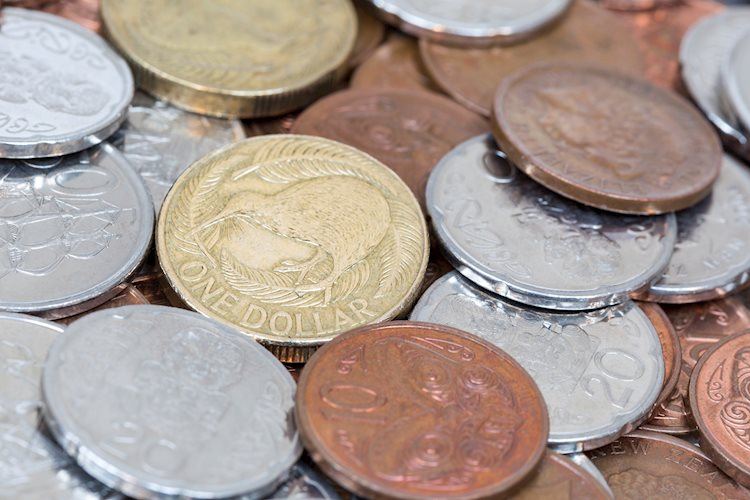- NZD/USD edges higher to near 0.6095 in Friday’s early Asian session.
- The US CPI inflation was higher than forecast in September, while jobless claims posted an unexpected rise.
- The dovish stance of the RBNZ might cap the pair’s upside.
The NZD/USD pair holds positive ground around 0.6095 during the early Asian session on Friday. However, the upside of the pair might be limited as firmer US September inflation lowers the odds of aggressive US Federal Reserve (Fed) cuts, which lift the Greenback. Investors await the Producer Price Index (PPI) and the preliminary Michigan Consumer Sentiment Index data, which are due later on Friday.
The US inflation surprised on the upside in September, with the Consumer Price Index (CPI) rising 2.4% YoY in September, compared to 2.5% in the previous month. Meanwhile, the core CPI, Ex-food & energy price growth, jumped 3.3% YoY in September versus 3.2% prior, hotter than the 3.2% expected. The higher-than-expected inflation report might boost the Greenback and cap the upside for NZD/USD.
The small upward surprise in September price growth is unlikely to prevent the Fed from additional interest rate cuts this year, but the odds of a 50 basis points (bps) reduction fell significantly after September’s strong US Nonfarm Payrolls report last week. The markets are now pricing in nearly 83.3% possibility of 25 basis points (bps) Fed rate cuts in November, according to the CME FedWatch Tool.
New York Fed President John Williams said on Thursday that he expects more rate cuts lie ahead as inflation pressures continue to moderate and the economy remains solid. Meanwhile, Chicago Fed President Austan Goolsbee noted he sees a series of rate reductions over the next year to year and a half, noting that inflation is now near the Fed’s 2% target, the economy is about at full employment, and the Fed’s goal is to freeze those conditions in place.
However, Atlanta Fed President Raphael Bostic is open to the idea of skipping a rate cut in November if economic data still hasn’t aligned with the Fed’s target figures in time.
On the Kiwi front, the dovish stance of the Reserve Bank of New Zealand (RBNZ) might cap the pair’s upside in the near term. The markets bet on more aggressive easing in November. Swaps imply there are a further 45 bps of easing to come at the RBNZ’s November meeting. However, the positive development surrounding the Chinese economy could lift the China-proxy New Zealand Dollar (NZD) as China is a major trading partner to New Zealand.
New Zealand Dollar FAQs
The New Zealand Dollar (NZD), also known as the Kiwi, is a well-known traded currency among investors. Its value is broadly determined by the health of the New Zealand economy and the country’s central bank policy. Still, there are some unique particularities that also can make NZD move. The performance of the Chinese economy tends to move the Kiwi because China is New Zealand’s biggest trading partner. Bad news for the Chinese economy likely means less New Zealand exports to the country, hitting the economy and thus its currency. Another factor moving NZD is dairy prices as the dairy industry is New Zealand’s main export. High dairy prices boost export income, contributing positively to the economy and thus to the NZD.
The Reserve Bank of New Zealand (RBNZ) aims to achieve and maintain an inflation rate between 1% and 3% over the medium term, with a focus to keep it near the 2% mid-point. To this end, the bank sets an appropriate level of interest rates. When inflation is too high, the RBNZ will increase interest rates to cool the economy, but the move will also make bond yields higher, increasing investors’ appeal to invest in the country and thus boosting NZD. On the contrary, lower interest rates tend to weaken NZD. The so-called rate differential, or how rates in New Zealand are or are expected to be compared to the ones set by the US Federal Reserve, can also play a key role in moving the NZD/USD pair.
Macroeconomic data releases in New Zealand are key to assess the state of the economy and can impact the New Zealand Dollar’s (NZD) valuation. A strong economy, based on high economic growth, low unemployment and high confidence is good for NZD. High economic growth attracts foreign investment and may encourage the Reserve Bank of New Zealand to increase interest rates, if this economic strength comes together with elevated inflation. Conversely, if economic data is weak, NZD is likely to depreciate.
The New Zealand Dollar (NZD) tends to strengthen during risk-on periods, or when investors perceive that broader market risks are low and are optimistic about growth. This tends to lead to a more favorable outlook for commodities and so-called ‘commodity currencies’ such as the Kiwi. Conversely, NZD tends to weaken at times of market turbulence or economic uncertainty as investors tend to sell higher-risk assets and flee to the more-stable safe havens.
Read the full article here

